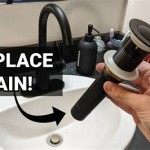How To Replace Bathroom Fan Duct
A properly functioning bathroom exhaust fan is crucial for removing excess moisture and preventing mold and mildew growth. A key component of this system is the ductwork, which channels the humid air outside. Damaged or improperly installed ductwork can significantly reduce the fan's effectiveness. This article provides a comprehensive guide on how to replace bathroom fan ductwork.
Assessing the Existing Ductwork
Before beginning the replacement process, a thorough assessment of the current ductwork is necessary. This involves identifying the duct material, diameter, and routing. Checking for kinks, blockages, and leaks is also vital.
Key Points:
- Inspect the duct material (flexible foil, rigid metal, or PVC).
- Measure the duct diameter for proper replacement sizing.
- Trace the duct route from the fan housing to the exterior vent.
- Check for any visible damage, kinks, or obstructions.
- Look for signs of leaks or disconnected sections.
Gathering Necessary Tools and Materials
Having the right tools and materials readily available will streamline the replacement process. The specific tools and materials may vary depending on the ductwork type and location.
Key Points:
- New ductwork (flexible or rigid) of the correct size and material.
- Duct tape (foil or appropriate type for the chosen duct material).
- Screwdriver (for accessing the fan housing and securing connections).
- Tin snips or utility knife (for cutting ductwork to length).
- Measuring tape (for accurate measurements).
- Safety glasses and gloves (for personal protection).
- Reciprocating saw (may be needed for cutting through existing ductwork).
- Drill and appropriate drill bits (for securing ductwork or creating access points if necessary).
Disconnecting the Existing Ductwork
Carefully disconnect the existing ductwork from both the fan housing and the exterior vent cap. This may involve loosening clamps, removing screws, or cutting the ductwork with tin snips or a reciprocating saw.
Key Points:
- Turn off power to the bathroom fan at the circuit breaker.
- Remove the fan grille to access the duct connection.
- Loosen clamps or screws securing the duct to the fan housing.
- Access the exterior vent cap and disconnect the duct from the termination point.
- Carefully remove the old ductwork, noting its routing.
Installing the New Ductwork
Begin by connecting the new ductwork to the fan housing using appropriate connectors and sealant. Ensure a tight and secure connection to prevent air leakage. Run the ductwork along the established route, avoiding kinks and sharp bends.
Key Points:
- Connect one end of the new ductwork to the fan housing outlet.
- Secure the connection with duct tape designed for the specific duct material.
- Route the ductwork along the path of the old duct, minimizing bends.
- Support the ductwork with straps or hangers as needed.
- Ensure smooth transitions and avoid kinks that restrict airflow.
Connecting to the Exterior Vent Cap
Connect the new ductwork to the exterior vent cap, ensuring a weathertight seal. Use sealant or caulk around the connection point to prevent water intrusion. Securely fasten the vent cap to the exterior wall.
Key Points:
- Extend the new ductwork to the exterior vent opening.
- Securely connect the duct to the vent cap using appropriate fasteners or sealant.
- Seal around the vent cap with weatherproof caulk to prevent leaks.
- Ensure the vent cap is properly secured to the exterior wall.
Testing the Installation
After completing the installation, thoroughly test the system to ensure proper operation. Turn the bathroom fan on and check for any unusual noises or vibrations. Verify that air is being effectively exhausted through the exterior vent.
Key Points:
- Restore power to the bathroom fan circuit.
- Turn the fan on and listen for unusual noises or vibrations.
- Check for proper airflow at the exterior vent.
- Inspect all connections for leaks or air gaps.
Insulating the Ductwork (Optional)
Insulating the ductwork can improve energy efficiency and reduce condensation, especially in colder climates. Use insulation specifically designed for ductwork and ensure it's properly secured.
Key Points:
- Wrap the ductwork with insulation, ensuring full coverage.
- Secure the insulation with tape or appropriate fasteners.
- Ensure the insulation does not obstruct airflow or create fire hazards.

Installing A Bathroom Fan Fine Homebuilding

Blog

Install A New Bathroom Vent Fan Light

How To Install A Bathroom Fan Diy Family Handyman

Fixing Bathroom Ventilation Problems Poorly Installed Ductwork And Insulation Jlc

How To Replace And Install A Bathroom Exhaust Fan From Start Finish For Beginners Easy Diy

Inspecting For Air Sealing At Kitchen And Bathroom Exhaust Fans Internachi

How To Use An In Line Exhaust Fan Vent Two Bathrooms Diy Family Handyman

How To Install A Bathroom Exhaust Fan

Bathroom Extractor Fan Install Using Rigid Plastic Duct
Related Posts







